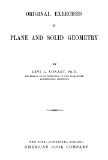| dc.contributor.author | Levi L Conant | |
| dc.date.accessioned | 2016-02-20T05:17:28Z | |
| dc.date.available | 2016-02-20T05:17:28Z | |
| dc.date.issued | 1905 | |
| dc.identifier.isbn | 1418179531,9781418179533 | |
| dc.identifier.issn | | |
| dc.identifier.uri | http://ir.nmu.org.ua/handle/GenofondUA/22139 | |
| dc.description.abstract | This historic book may have numerous typos and missing text. Purchasers can download a free scanned copy of the original book (without typos) from the publisher. Not indexed. Not illustrated. 1905. Excerpt: ... II. THE CIRCLE 101. If the inscribed and circumscribed circles of a triangle are concentric, the triangle is equilateral. What modification of this theorem must be made for the isosceles triangle? 102. Three consecutive sides of an inscribed quadrilateral subtend arcs of 75, 92, 104, respectively; find each angle of the quadrilateral, and the angles between the diagonals. 103. A triangle is formed by joining the points of contact of a circumscribed triangle; prove that any angle of the inscribed triangle is equal to a right angle minus half the opposite angle of the circumscribed triangle. 104. What is the locus (i) of the middle points of a system of parallel chords in a circle? (ii) Of the middle points of a system of equal chords? 105. The perpendiculars erected at the middle points of the sides of an inscribed quadrilateral are concurrent. What if it be a pentagon? A hexagon? 106. The line joining the middle points of the nonparallel sides of a circumscribed trapezoid is equal to one fourth the perimeter. What, then, is its value in terms of the non-parallel sides? 107. If two of the adjacent sides of an inscribed quadrilateral subtend arcs of 70 and 110, respectively, and one of the angles formed by the diagonals is 95, find each of the angles of the quadrilateral. 108. The line joining the middle points of the arcs subtended by the sides of an inscribed angle A intersects the sides of the angle in B, C, respectively; prove AB = A0. 109. The sum of the alternate angles of an inscribed octagon is equal to six right angles. What is the generalization of the preceding theorem for any inscribed polygon having an even number of sides? 110. What is the ratio between the sides of an inscribed and of a circumscribed equilateral triangle? Is the ratio the sam... | |
| dc.language.iso | English | |
| dc.publisher | American Book Company | |
| dc.subject | | |
| dc.subject | | |
| dc.subject.ddc | | |
| dc.subject.lcc | | |
| dc.title | Original Exercises in Plane and Solid Geometry | |
| dc.type | other | |
| dc.identifier.aich | ILS57ACEIKRVO4S5NQVSBHVQF6DK4YGF | |
| dc.identifier.crc32 | 7F808A18 | |
| dc.identifier.doi | | |
| dc.identifier.edonkey | C9302F5FB159C42ECC638FD8AF19882A | |
| dc.identifier.googlebookid | | |
| dc.identifier.openlibraryid | OL11787947M | |
| dc.identifier.udk | | |
| dc.identifier.bbk | | |
| dc.identifier.libgenid | 832589 | |
| dc.identifier.md5 | bcf9f11558b74eb192f5c8c91d6bb6d8 | |
| dc.identifier.sha1 | LSLKI56HGMA6Z7J4ZBH5XLEDDG2ZZUPC | |
| dc.identifier.tth | BEWSDG73L3GG24A4LBF634N2ZFRETPBFM3EOG5Y | |

